If you believe the advertisements of smartphone manufacturers, the cameras of those devices are amazing and suitable for professional use. Sometimes (often?) these advertisements turn out to be fake, shot with professional DSLR cameras. But how good are those smartphone cameras really?
I went on holiday to the Sächsische Schweiz, an amazing area in the South of Germany with beautiful shaped rock formations and table mountains. We went to relax, and to scout the area at the same time. Photography was not the most important thing during this short holiday. Nevertheless, we took our cameras with us, and a small travel tripod, just in case we would stumble upon a great scenery. Of course, we found many.
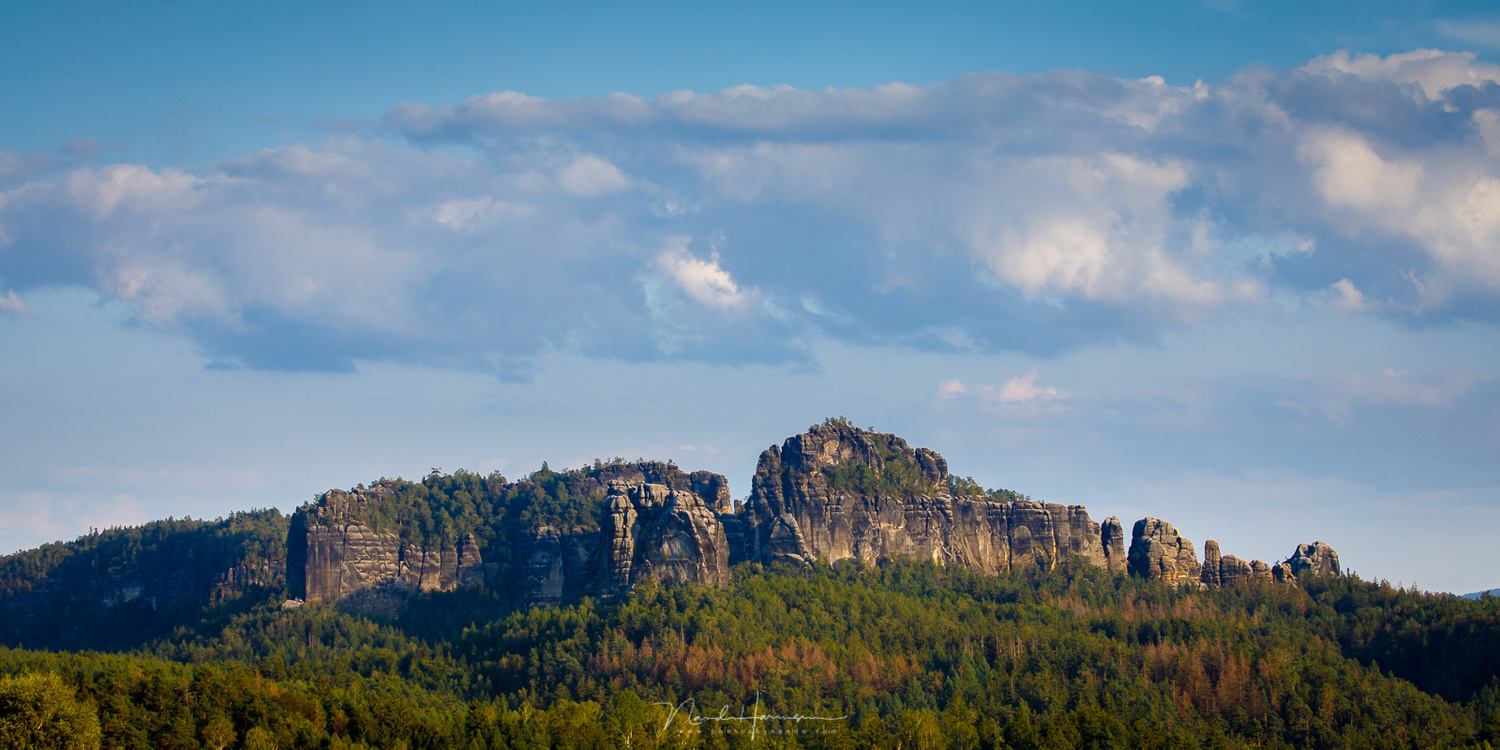
The beautiful rock formations of the Sächsische Schweiz in Germany. It is an amazing landscape to photograph (Canon EOS 5D4 114mm | ISO100 | f/8 | 1/200)
Often we went on a hike with nothing more than a light backpack and my compact Fujifilm X100t. And occasionally I used my smartphone for a simple quick shot, just for the family album. For that I always used the build in camera app, shooting simple jpg images. I shot many photos like this during the previous photo tours at France, Lofoten, and Faroe Islands. Just memories, or for the family album. But I found out, thanks to the videos of Nigel Danson, it is also possible to shoot dng raw files with a smartphone. You can do this with the help of the Lightroom Mobile app, or one of the many other apps that are built for those purposes.
One day we hiked up to a prominent rock called the Gohrische Stein. Because my X100t could not capture the complete rock in one shot, due to the fixed focal length, I choose to capture the rock with my smartphone also, in dng file format. After all, it has a shorter focal length.
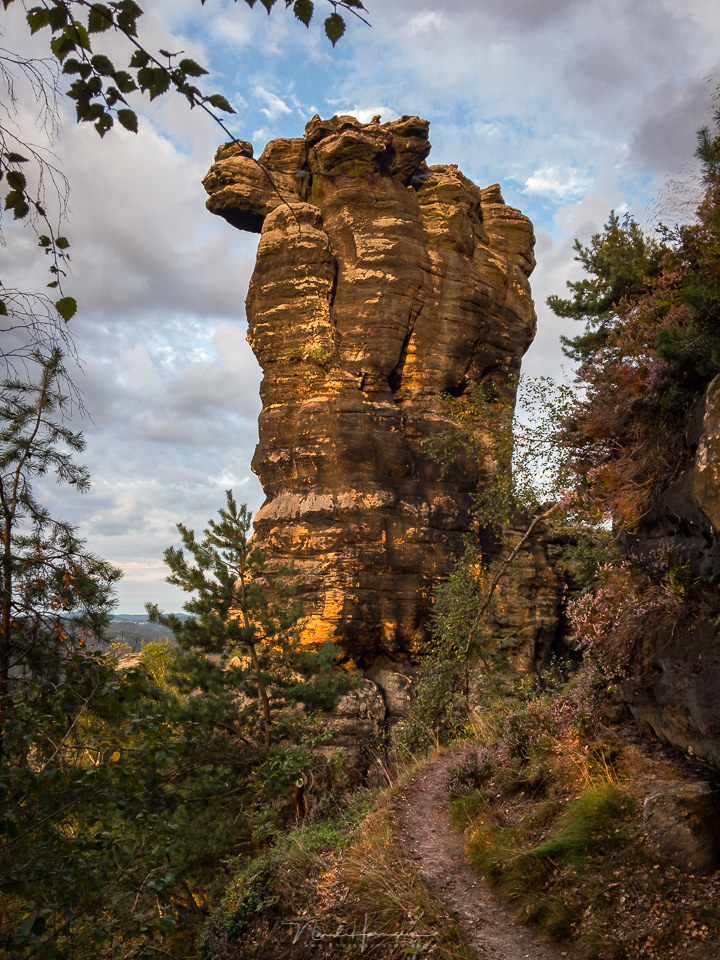
This is the Gohrische Stein, and it takes a nice hike to reach it. It is lit by the setting sun, and shot in DNG file format with my smartphone. It manages to capture the complete dynamic range. (iPhone 6s | 4mm | ISO25 | f/2,2 | 1/115 | HDR setting enabled)
After I looked a the result in Lightroom Mobile I was surprised of the quality. Well, on that small screen at least. I shot this photo with the option HDR, thus increasing the dynamic range as much as possible.
The next day we witnessed a great sunset from another amazing location, and after I took some pictures with my X100t, I tried one last shot with my smartphone. And it took me by surprise to see the result.

Sunset from the path over the Kleiner Winterberg. A quick capture with my smartphone in DNG file format and post-processed in Lightroom. (iPhone 6s | 4mm | ISO25 | f/2,2 | 1/900 with -2,7EV | HDR setting enabled)
A few days later I noticed some grass on the banks of the river Elbe, perfect for a nice photo. Since my girlfriend used my tripod at that moment, I took the photo I had in mind with my smartphone. To be honest, I was blown away with the result, since it was shot directly into the sun. At that moment I decided to do some comparison between the smartphone and the Fujifilm X100t, and even the Canon EOS 5D Mark IV. I knew it wasn’t a scientific comparison, but it would be interesting to see how well my smartphone would hold up to professional cameras. On the banks of the river Elbe I needed bracketing on my Fujifilm X100t to capture that same shot without flares. You can see the results below.

A late afternoon at the Elbe, shot with a smartphone. It had no problem with the direct sunlight. Shot in DNG format and post-processed in Lightroom (iPhone 6s | 4mm | ISO25 | f/2,2 | 1/77000 with -4EV | HDR function enabled)

The same scenery shot with the Fujfilm. Although it could capture this scenery in one shot, I used two exposures to get rid of the strange flares. (Fujifilm X100t | 23mm | ISO800 | f/16 | 1/25 | in-camera DR400 enabled)
On another occasion we stood high upon one of the amazing rock formations, looking over the stunning landscape with the sun shining through a thin layer of clouds. This time I had my Canon EOS 5D Mark IV with me, and I took a series of bracketing shots to capture the scenery in the best possible quality. It is full of details and a keen eye will even spot a nice sundog at the left side of the sun.

A view from Carolafelsen. I composed this image from five bracketing shots with my Canon camera, and merged it in Lightroom. (Canon EOS 5D4 16mm ISO100 | f/11 | 1/60 with 2 stops bracketing)
While enjoying the view I thought it would be perfect to take ta similar shot with my smartphone, with the HDR function enabled, thinking it would be another great test to see how the light situation would affect the result. Now, after post-processing the dng file with Lightroom, I have to say the result is amazing, although the feel of the photo does not match that of the Canon. Do not forget, the photo made with the Canon is the result of bracketing.

I also took this image with my smartphone. I thought it would be nice to compare this with the result from my dslr camera. I am impressed. (iPhone 6s | 4mm | ISO25 | f/2,2 | 1/26000 with -4EV | HDR function enabled)
I also shot some comparison photos under easy light situations. When we visited the famous Bastei bridge, high above the river Elbe, I could not capture the complete bridge in one shot. I made a panorama with the X100t by using six vertical shots. And I used three photos from my smartphone for another nice panoramic view of that famous bridge.
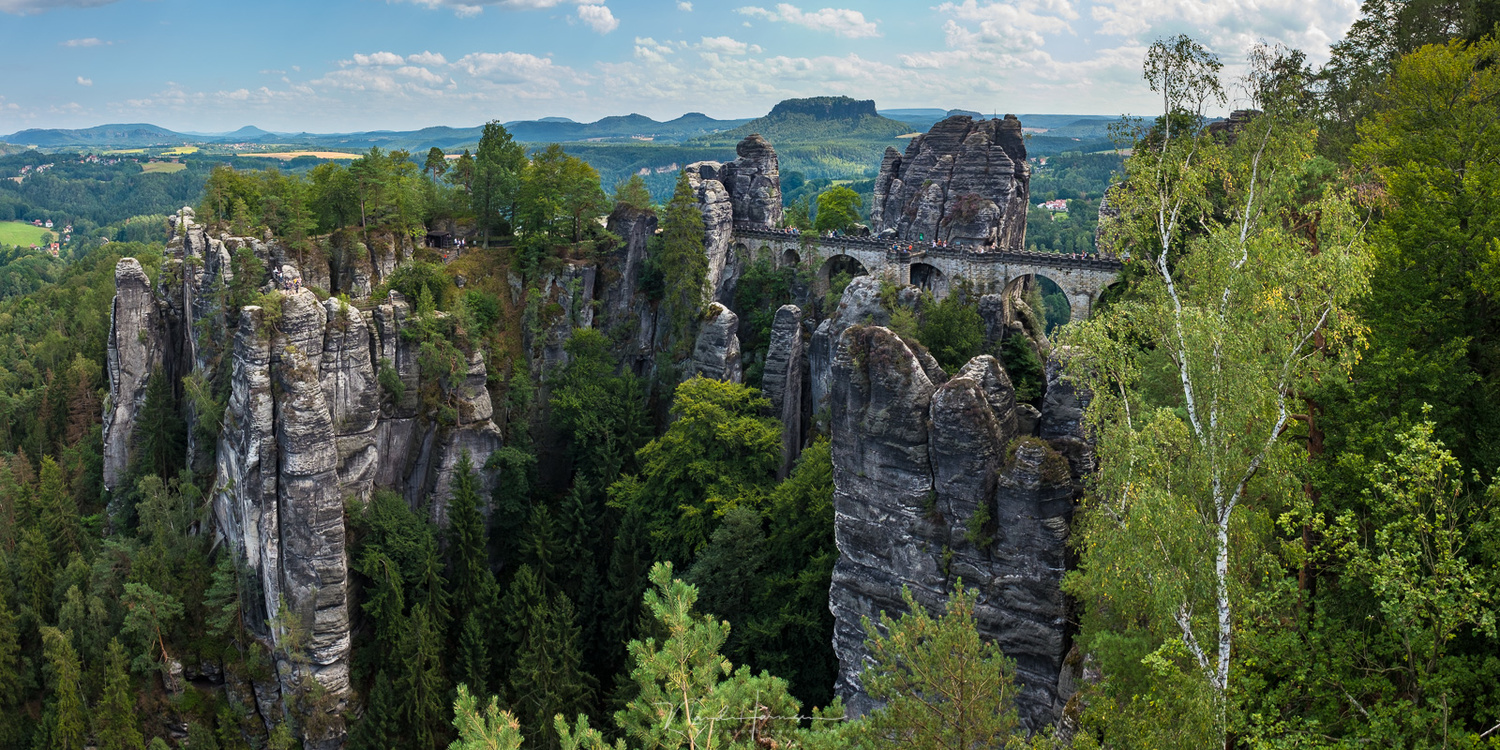
The famous Bastei, shot with my Fujifilm. It is a handhold panorama from six vertical shots, stitched in Lightroom. (Fujifilm X100t | 23mm | ISO200 | f/10 | 1/140 with -1EV)

My smartphone has a shorter focal length compared to the X100t, and I managed to capture a wider scenery. This is a panorama from three shots, made with my smartphone. (iPhone 6s | 4mm | ISO25 | f/2,2 | 1/8500 with -2EV | HDR function enabled)
With these results you may wonder if a large DSLR or other (semi) professional camera still has some benefit. The dynamic range that can be captured with a smartphone is amazing, and you seem get stunning results, even with a strong backlight scenery. But what if it becomes dark. Does the smartphone still hold up to the quality you get with a professional camera?
After a long hike we reached the village of Schmilka on the Czech border. At that time it was almost dark, but there was still some color left in the sky. I managed to capture a nice silhouette of the rock formation Kleine Bastei. My DSLR had no problem capturing a landscape under these circumstances, but the smartphone wasn't able to do so. At least, with the Lightroom Mobile photo app I used for this. To have some comparison, just five minutes before I took a quick smartphone shot of my girlfriend when she entered the village of Schmilka. The auto focus wasn't able to lock on, the noise levels are very high, and details are lost. This photo is nearly unusable.
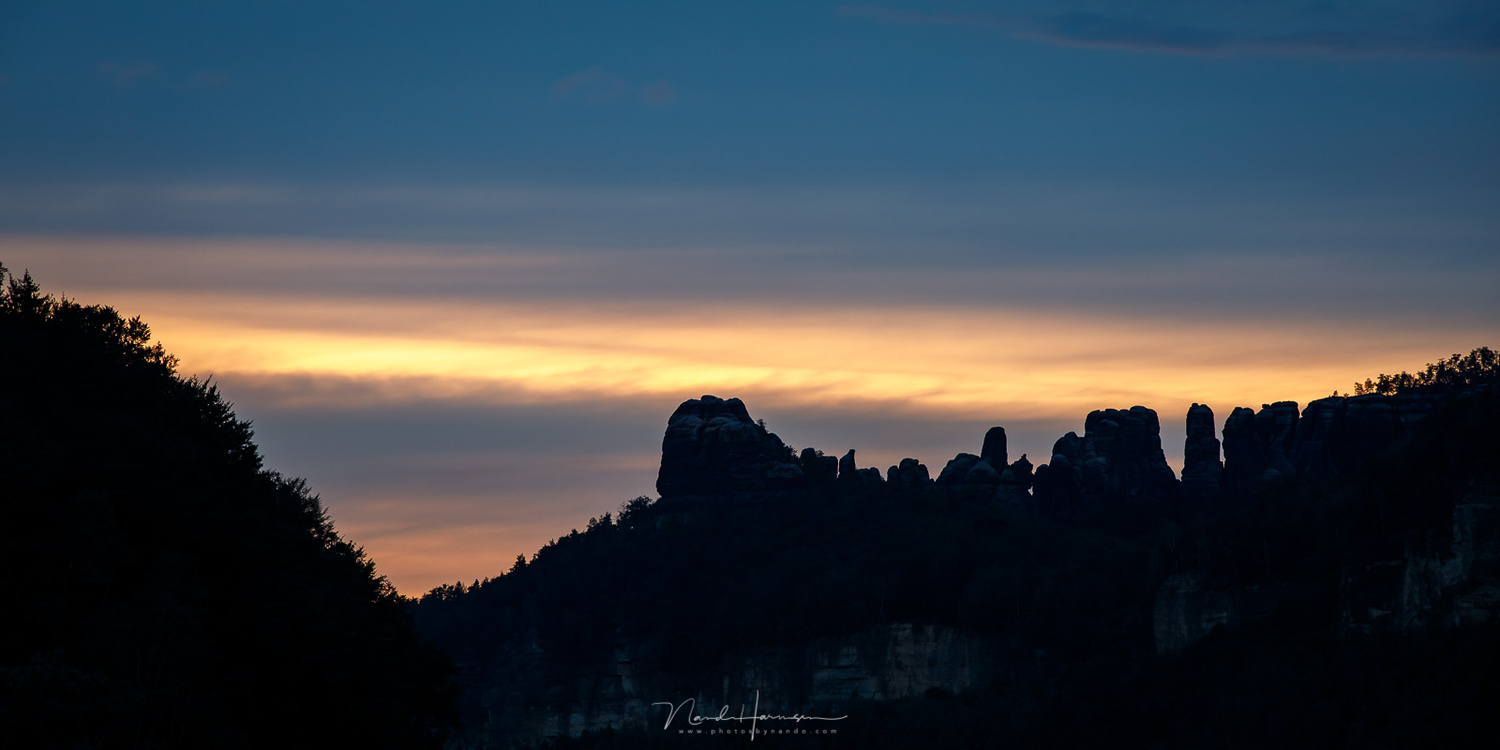
For these kind of photos you need a bit more than a smartphone. When it becomes too dark, your smartphone will run into its limitations. (Canon EOS 5D4 200mm | ISO100 | f/8 | 2,5sec)
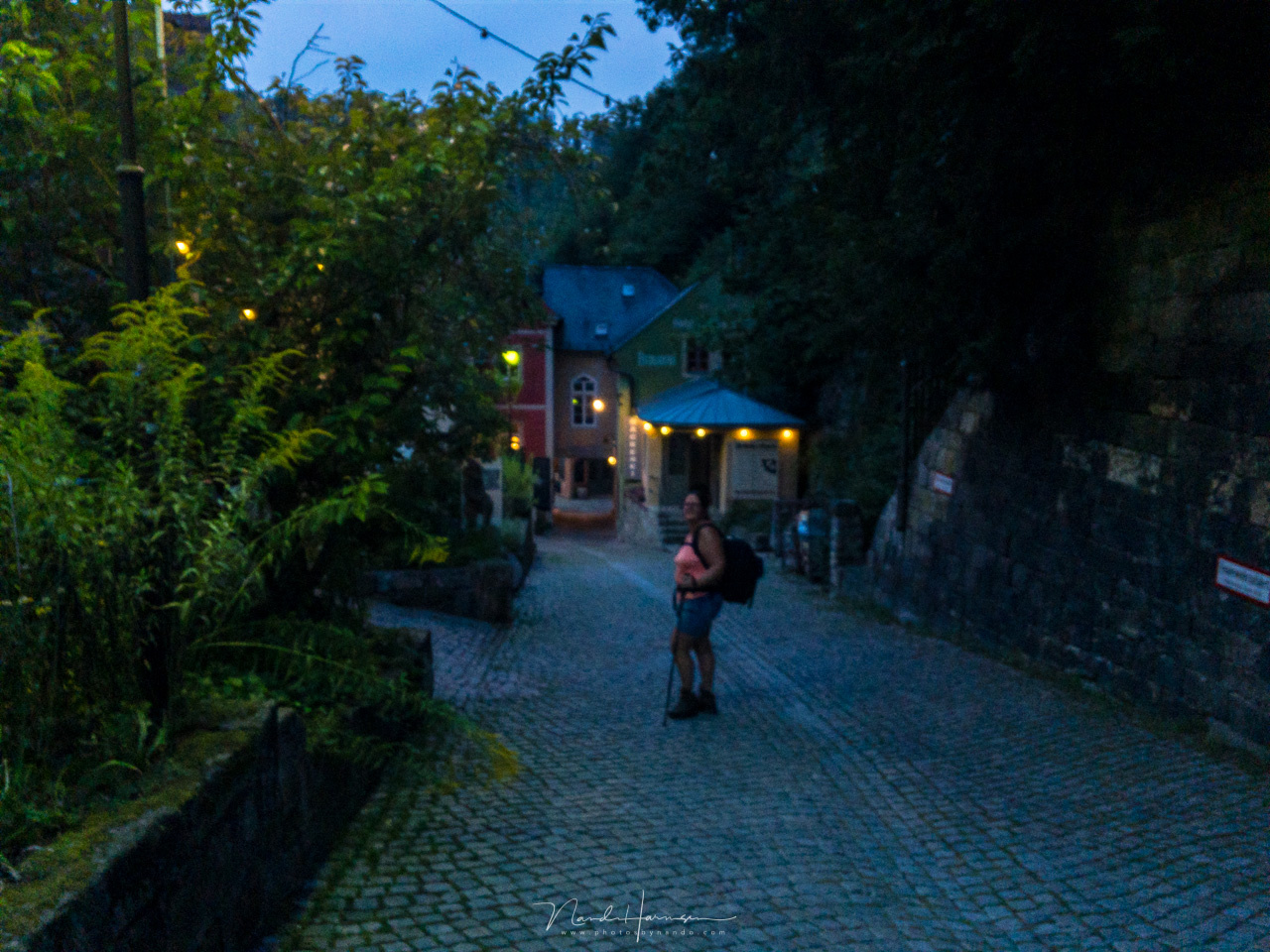
I captured my girlfriend when we entered the village of Schmilka, after a long hike. It was already getting dark, a situation that offered a real challenge for the smartphone. (iPhone 6s | 4mm | ISO40 | f/2,2 | 1/35 with -5,3EV | HDR function enabled)
It made me wonder again how the image quality of all those other images was. Up to now these pictures are presented in web sized quality, which is very forgiving. But what if we look a little bit closer, at 100%. Of course it is difficult to make an honest comparison between a 30 megapixel photo from the Canon 5D Mark IV, and a 12 megapixel photo from the iPhone 6s, but I wanted to see the difference nevertheless. Remember, the Canon photo is the result of merging five shots from a series of exposure bracketing, the smartphone is with the HDR function enabled.
I have discovered a few things from shooting with a smartphone during our holiday in the Sächsische Schweiz. The quality of the smartphone images is amazing, from my iPhone 6s, at least. Even shooting with strong backlight, with the HDR function enabled, produces good results. And I am convinced the newer smartphones will have even better cameras.
The photos from a smartphone are very useable for social media and use on websites, and even for the family photo album. But when it comes to professional use, the quality does not hold up to the (semi) professional cameras with larger sensors and infinite better lenses. When the light is fading, a smartphone camera becomes unusable very quickly.
There is another downside to smartphone cameras I did not mention. It is not possible to use tele lenses. And although there are solutions available for that, these will never have the quality of a camera with a larger sensor and interchangeable lenses.
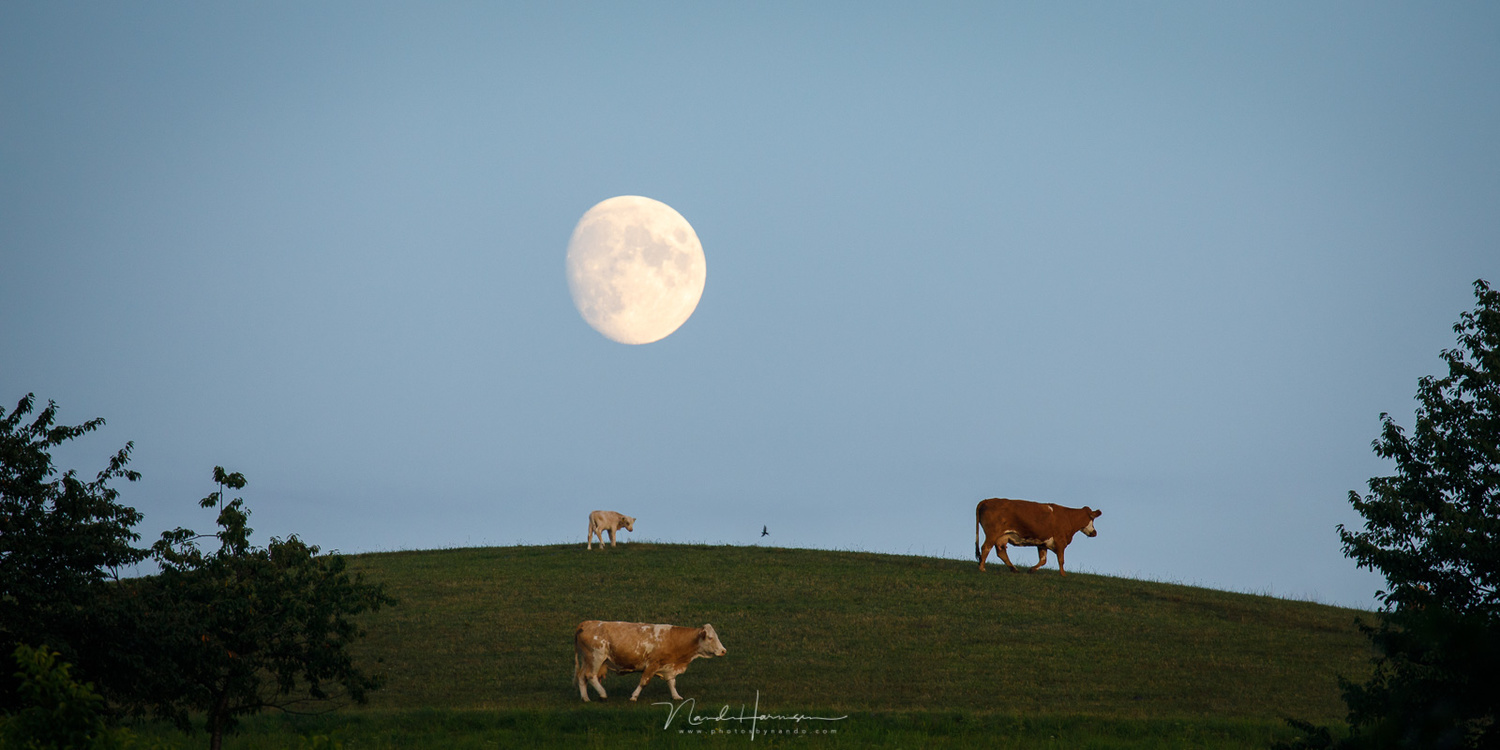
Shooting with a smartphone has its limitations. You can never shoot something like this photo, so my smartphone will never be able to replace my camera, but it is nice to have available for the pictures in the family album. (Canon EOS 5D4 400mm | ISO250 | f/8 | 1/125)
I guess you own a smartphone. Who doesn’t? Please let me know in the comment how you use your smartphone camera. Is it just for fun shots, or in a more serious manner? I would love to hear about your experiences.









I use my smartphone camera for one purpose only... selfies in cafes, to send to my girlfriend on Facebook. I use my smartphone only to order Grab taxis to and from cafes and restaurants.
I really hate smartphones. If I could work out a way of summoning a taxi in South East Asia that wouldn't be a total rip off in any other way, I'd throw my smartphone away.
This isn't camera snobbery. I like the images from my Honor 8X, it's about breaking free of the screens that are ruining the world.
Sorry to say that, but you're losing an excellent opportunity of explore many situations that only a cell phone in hands could to capture.
I don't feel I am. I carry my X100F everywhere and I really do mean everywhere (except when I go to the bathroom, usually).
There has never been a time in my life when I felt I was missing out on a photo because I didn't have a cellphone on me. I hate using cellphones and it's never going to be something that I want to get used to.
Loss is what you make it. It's not a loss to me, it's a significant gain not to be attached to electronic devices 24 hours a day like a dependent child to a mother's breast.
I was talking about cell phones in a photographic context.
You're just waffling now. Your 2nd comment is even less insightful than your first. If you can't read, it's best not to waste your time online - maybe schooling could help?
...
You keep talking because you seem unable to listen. There is no missed opportunity for me. No matter how I spell this out, you keep blathering. Maybe this is something you learned from a woman or while smoking pot and wasting your life? If so, unlearn it. It is neither manly nor seemly.
...
You can buy cream for that butthurt bro. I am sure you already know that though, you must get it a lot when you prove yourself unable to read on the Internet over and over and over again.
...
Cellphone cameras certainly have a purpose but until they get good optical zoom and more than just a fixed aperture, photos will be really limited.
I'm not actually sure if phones are going to get better. AI processing does some wonders but not if you do any pixel peeping. In fact I believe the sensor in my Pixel 3 xl is worse than my old 2015 Nexus 6p when it comes to straight out of the camera raw. With my 6P I use to use the Lightroom app to capture photos in Raw DNG and do some editing in the app. I tried the same with my Pixel 3 xl and I feel the raw images are worse. The in phone camera app using HDR enhanced does a better job at dynamic range over just a single raw but the images up close are crap. I usually just bring them down to 1600px for any social media uploading which is perfectly fine but I would never try to print one.
I've taken some good image with my phone. Example shown but once you know anything about photography and raw editing raw, you'll notice the limitations to a phone really quick. This image just happens to be with-in those parameters so beside some corner sharpness it wouldn't matter if it was a slr or not.
Thanks for your thoughts. I agree, the use is limited and the quality is not as good as a larger sensor camera.
I used to carry a DSLR (Canon 6D) and after one sweaty, hot trip to Cambodia I decided I needed something MUCH lighter, so I got a Sony RX100 III. Then I got an iPhone 8 and installed Lightroom and was in love with the quality and immediacy of processing photos on the spot, so I took couple of trips using only that option (with clip-on lenses, a wide angle and a “tele”). It was fun, and so liberating to travel ultra light with a waterproof camera :) Also, you are super uncospicious, able to get some great candid shots. But of course, the low-light shots suffered, even though I managed to print some very good 17x22 daytime shots. My next trip is to Japan, so I will lug a full frame again (although mirrorless this time), since I figure it is too photogenic of a place to play with the opportunity. I would really love a middle ground: a large sensor camera with interchangeable lenses AND full Lightroom capture (especially RAW HDR) and processing options. Zeiss ZX1 is going in that direction, minus the interchangeable lenses.
The example below was taken with the iPhone 8, using a “long exposure” option in Lightroom app, shot hand held, then processed on the spot. It all took a few minutes. To achieve the same result with a conventional camera would take so much longer, either using a tripod and ND filters or merging several shots in post. One HUGE caveat: iPhone can get very hot and slow down, even shut down completely, while processing numerous Lightroom RAW captures (not even editing, just the shots). You CAN keep shooting without problems as long as you don’t leave the camera module, your photos will be stored in a buffer and processed once you go back to the library view.
My experience mirrors yours, right down to the RX100III. I agree the ZX1 is a step in the direction of the future workflow.
Really nice result. I wonder if the quality holds when printing in large sizes.
But I don't mind if a conventional camera takes more time to shoot something like this. After all, if it is a hobby, it does not matter if it takes time. :)
Shots with plenty of light are surprisingly detailed and print fine at 13" x 19" or even bigger (depending on the subject, texture, etc.). The biggest problem in those situations for me turned out to be misaligned clip-on lenses, blurring the corners. Using a specific phone case for your lenses mitigates that problem, but I don't have it.
And even in low light, the results are quite OK.
The samples below were taken with the iPhone 8, using the Lightroom app in HDR mode, hand held. Even in the dim conditions, the iso stayed at 25. If you would print at 13" x 19", the magnified areas would measure just about 2.5" x 3.5", so the noise wouldn't even be that problematic (it actually reminds me of film grain). For my next trip I will take both the phone lenses and a full frame camera and do some comparison shots out of curiosity.
Just like I saw; the details are not that great with these magnifications. A camera with a bigger sensor would have captured more detail, would have produced a sharper image.
But, I think this smartphone result would be enough for this size print. Nobody would look at a print this size from just a few inches.
Oh, by all means the larger sensor wins very clearly; even using a 1" produces abysmally better results. But the computational photography manages to stretch the limits of phone sensor size and dynamic range to levels unthinkable just a short time ago. I shoot architecture and interiors for work, so I can be too perfectionist most of the time and obsessive about sharpness and detail. So it was fun, and liberating, seeing these results from such a tiny device, and with such immediacy (both processing and sharing). Also, there are usually several spots during each trip where conventional cameras are not convenient or even allowed at all, while everyone is so used to smartphones they tend to get overlooked or ignored — you can even shoot from the hip while pretending to simply hold it and get that impossible shot ;)
Indeed. I never thought about that; locations where photography isn't allowed, a smartphone almost often is.
Mine gets used for client images. Yes..
I often have to shoot ‘consumer’ images for their social media campaigns. So a smartphone in a bar to get a nice consumer shot of a beer. Ideal. Absolutely nothing wrong with doing so either, a mater of using the right tool for the job.
I do the same thing except the actual camera is just for fun. Im not a professional photographer that takes decent pictures. When I go out I'll snap shots with the phone and post them on my Instagram stories and tag the business. Sometimes they will comp me free drinks and I'm happy.
For websized use the quality is enough. So why not use it for this purpose. Personally I would never use a smartphone for client images.
Don't then.
I use the tool that suits the job. In the work I do, sometimes that is the exact right tool and achieves what the client needs in a way all the bags for of expensive stuff I have can't.
Believe it or not, a shot I made with a smart phone was used on a 5x5meter hoarding once.
It is perfectly possible to shoot beatiful with cell phones especially if you only use your images to post in internet (facebook, instagram etc.).
Nice examples. In this world of internet use only, these will do perfectly.
Not one article about the BMPCC 6K but iphone articles a plenty. The screenshots I get from the new 6k are better than apple pocket cameras so can we focus on something different for a change.
This article is not about an iPhone, but about use of smartphone cameras. I was convinced that was obvious.
I use Pixel 2 camera during scouting, figuring out the final composition to shoot and sometimes take pictures when I don't bring my camera (something is better than nothing case). For printing purposes (above 8x10), viewing on 4K montor/TV or editing, cellphone camera images fall apart.
When I look at my smartphone pictures on a 4K monitor, the images are very acceptable. Even editing, up to a certain level. These images will never have the quality of a larger sensor.
For vacation photos, absolutely. My old LG5 and my new Huawei P20 Pro take amazing photos, a couple of them are enlarged to 18x24 and hanging on our walls.
I consider my mobile phone as an essential part of my gear for photography.
I think the main reason why most people are snobbish to the mobile phone camera is because they have very high expectations.
Of course it has a lot of limitations. What people need to understand is you need to workaround these limitations and be realistic on what kind of photography you must do when using mobile phone cameras.
Camera's are tools for the job. Same applies with knives: It's not proper to use a paring knife to butcher meat, at the same time it is not proper to use a cleaver to finely peel fruits and garnishes, even though you know you can possibly do both those things with the both of them.
I used a Fujifilm X100t for my trip, as mentioned in the article. That camera has a fixed focal length of 23mm (35mm full frame equivalent). It has the same limitation as a smartphone camera.
Just like you said... you have to think out of the box and use a workaround...
Like everything else photography, it depends on the job you expect the camera to do. I use my iPhone all the time, and get some amazing shots, but there are lots of examples where my a6000 or even the RX100III does the job a cell can not. Then again, neither the a6000 or RX100 can share images as easily as the phone.
Well, there are cameras available that can share the photos directly with social media. The merge has already started. ;)
I do consider it regularly, then I run out of other options.
The reason to use a "big camera" has a lot more to do with tools and functionality than it does with image results. I also think that generally I get better results out of my DSLRs, and for my professional work, that is important. However even more important in my professional work, is a number of features that phones just cannot offer.
Just because you can do most of your mechanic work on your vehicle with a $130 tool set you get at the hardware store, doesnt mean that a professional mechanic wont have tens of thousands of dollars in specialized tools. Photography is no different.
Using cameras is more about the versatility they offer, the accessibility to certain tools in them, and the adaptability to different tasks that a phone just does not do.
True... the big camera offers more possibilities, and brings you things a smartphone never will.
I guess this question in the headline is just a matter of what the final picture shall be used for.
I am not a pro, nor a prosumer. I switched to the smartphone world of photography entirely, leaving my Nikon D7000 at home almost all the time.
I also do not edit photos in any photo tool, neither on the mobile device nor on the laptop. The only thing I do is cropping images.
I am not on Instagram or Facebook I just share the pictures with friends and family via messaging apps.
Sometimes, when friends are around, we display the pictures from the last vacation on the TV screen. That TV Screen is HDTV, so no fancy 4K or even 8K. Sometimes I also make a photobook in A4.
Based on my use case smartphones do the job well enough.
I had the photos of my wedding shot by a pro. He of course had multiple DSLR cameras as well as lightning gear and he did also process the images afterwards. Could he do his job a smartphone only? I assume not, at least the set of pictures would miss some shots made from a distance.
But then in the end, a subset of those pro wedding pictures are part of a screensaver of that same TV screen.
Would BBC be able to do a documentary about the wildlife in Africa. Again, I guess not, although I have done nice shots of elephants etc. myself.
The one thing that smartphones lack for sure is tele capability.
So to answer the question. Yes, for me, I do consider a smartphone for my photography. But as I said my requirements are different to those of you who do this for a living.
------
Off topic, funny you say Sächsische Schweiz is in the South of Germany :-) but I guess that is a matter of perspective. Despite that, I like the pictures you have taken and I assume you would be even more impressed with a later version of your smartphone gear.
If it works for you, that is perfect. It reminds me of my son. He bought a cheap dslr, but during a vacation he only used his smartphone. It was much easier, quicker, and it was not that heavy. ;)
Off topic... what do you mean about the location of the Sächsische Schweiz? A matter of perspective? I am not sure what you mean by that
I use my cell all the time, but only occasionally for clients -- generally an unplanned news opportunity that's going into newsprint where it will look fine in that medium, particularly at a 4-5 inch wide size.
Usually for now, some people use there smartphone for photography. But, is there any gear/flash that compatible with smartphone?